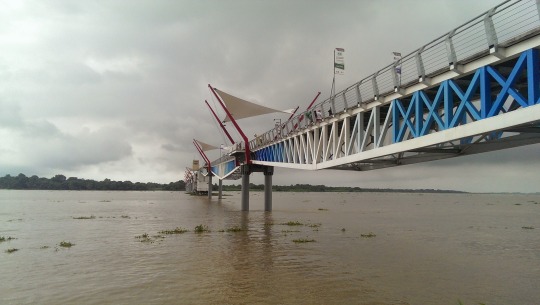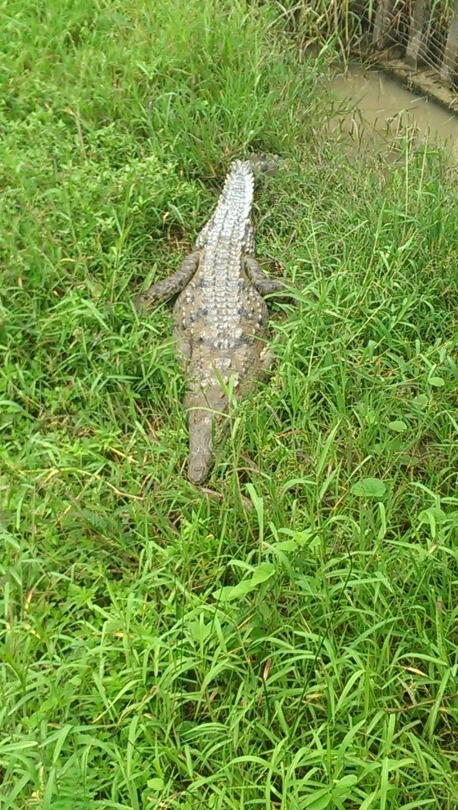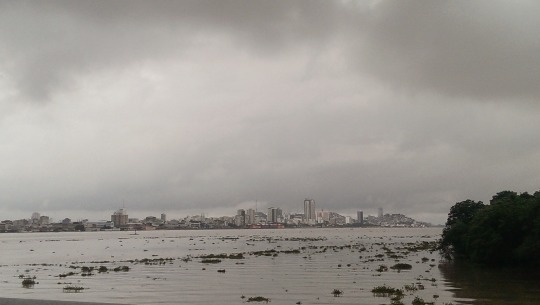So, I haven’t posted in forever, and there’s no good excuse for that. I have at times been fairly busy. But not that busy. I’m actually up in Quito, and have been since the beginning of April. I’ll be here two more weeks. I’m up working at the Embassy because two of the consular officers here are out on paternity leave. It’s been great to meet new people here, check out some of the sights around Quito and nearby, as well as interesting to note the differences in the applicants (as a reflection of the different cultures of the two cities. But, I’m kind of picky about keeping the posts in chronological order, so below is one of the last things I did before I left Guayaquil.

(the bridge out to the island)
Within my section of the Consulate there are probably 20 or so Ecuadorians and ten of us Americans. Most of the Ecuadorians are married, maybe with a few kids. I don’t know them all too well, but they are generally incredibly kind, helpful, smart people, with some of them having studied or lived in the US for periods of time. On the other side of the interview windows, where all the visa applicants are (or Americans renewing passports, etc.), there are what are called “greeters.” The greeters check in the`applicants against the appointment list, check to make sure they have the proper documents, and help them through the lines and make sure they get to the correct window when their names or numbers are called. The greeters are mostly college students, with a few that are 24 or 25. They work for a company that the State Department contracts, and most work part time (7:00-11:00 or 12:00). This alows them to attend classes in the afternoon or at night. Some of the ones that have already graduated have young kids or small businesses, and so like the ability to have time with their young kids, or they work their other jobs in the afternoon. During my first month or so, I slowly got to know some of the greeters, and have made good friends with a few of them. I’ve grilled out and watched soccer with them, met up at a bar/restaurant to watch more soccer, and went out dancing/singing late one night for one of the greeter’s birthday.

(crocodile chilling in the marsh)
Before the late night partying (and I mean like sunrise late) I got together with a group of greeters to ride bikes around Isla Santay. Isla Santay is an island in the Guayas River right across from Guayaquil. Guayaquil is mostly on the West bank of the river, but there is plenty of development on the other side of the river, and up the river a bit, where it splits off to the side. But, right in the middle of the river, right across from the center of Guayaquil is a pretty sizeable island (5,000 acres or so). The island has been inhabited for a long time, but never was developed much because most of it is mangrove swamps, and seasonal rises and falls in the river’s level make a lot of the island underwater at some point of the year. It was inhabited by farmers living on stilt houses who would fish in the mangrove swamps, and raised some animals on the stable land. During the 1900s, rice farms sprouted up on parts of the island. But, it remained much, much less developed than Guayaquil. In the ‘90s, the national government decided to protect much of the island, due to the various animal and plant species that are unique to the mangrove swamps. So, a raised trail was built around the island, and new homes, as well as a small tourist center, were built. Only the families that had lived there before are allowed to live there-so they make up the staff at the few restaurants, the boat tours, and as tour guides. This was kind of a trade the government made, in exchange for the rice and dairy farms being mostly closed and returned to natural growth.

(Guayaquil from island, across the Guayas River)
So, from Guayaquil (right next to a big banana export office building) you can rent bicycles, and ride over the bike and pedestrian only bridge (constructed just last year) to the island, and then ride around it. We stopped to walk on some raised paths and see a few wild crocodiles. It was drizzly and cloudy most of the day, but we still had a good time-and it did create a very humid, rain forest type atmosphere as we rode on the raised platforms. As you can see from the pictures, the Guayas River is about as ugly as rivers can get. It always has lots of plants and driftwood floating, as it’s an estuary-the tide brings everything the river tries to get rid of. But, it’s a very navigable river and incredibly calm and safe natural harbor-and that’s why the largest city in Ecuador is where it is.

(view of Guayaquil from the bridge, a very cloudy Guayaquil)